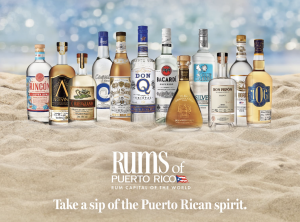Puerto Rico Debuts Premium Artisanal Rum Collection, Reinforcing Its Title as the Rum Capital of the World
Backed by the Department of Economic Development and Commerce (DDEC), this initiative is rooted in a centuries-old tradition of excellence. From world-renowned producers to emerging craft distilleries, Puerto Rican rum has earned its reputation through purity, complexity, and meticulous production. That legacy is now enriched with the addition of Artesano Rum, Boricua Rum, Caray Rum, Ron Pepon, Tres Clavos Rum, and Trigo Reserva Aneja Rum. A new generation of labels that blend passion, technique, and distinctive character.
These emerging distillers represent the island's expanding network of 11 rum distilleries, which produce more than 80 rum expressions, showcasing the diversity and expertise of Puerto Rican rum makers.
These brands took center stage at the Seatrade Cruise Global Show and F&B@Sea Expo in Miami, drawing attention from spirits professionals and distributors eager for authentic, high-quality rums.
The launch coincided with F1 Miami festivities, where the “Rums, Cars & Cigars” event— hosted by the Ferrari Miami Chapter—allowed elite guests to savor Puerto Rico’s artisanal rums alongside luxury cars and fine cigars, setting a new standard for experiential branding.
At the prestigious VINEXPO America 2025 in Miami Beach, Puerto Rican rums continued to shine. Distributors such as Mexcor Florida and Dozortev & Son (New Jersey) are committed to carrying select artisan labels, with California and Illinois expected to follow in the third quarter of 2025. These deals mark a significant step forward in expanding the island's rum footprint in both the U.S. and Latin America.
Sebastián Negrón-Reichard, Secretary of the Department of Economic Development and Commerce of Puerto Rico, emphasized that his office is committed to promoting all rum-related enterprises across the island, from small-batch distilleries to global powerhouses.
“Puerto Rico’s rum industry is a pillar of our economy and culture. Our support extends across the board—from the largest producers like Bacardí, Don Q, and Caribbean Distillers, to the new wave of artisanal innovators,” said Secretary Negrón-Reichard. “We are proud to showcase our heritage and quality to the world, and our goal is clear: make Puerto Rican rum the global standard.”
Upcoming Highlights:
• Puerto Rican Summit – Orlando, FL
• “Rum Is Fun” Book Launch
• Brooklyn Bar Convent
• Whiskies & Fire Tour, Austin Texas – Featuring Puerto Rico’s only rum entry and a live masterclass
With more than 80 expressions across 11 distilleries, Puerto Rico’s rum industry continues to evolve, blending century-old traditions with innovation. The collaborative efforts between government and industry ensure that the Rums of Puerto Rico remain a symbol of excellence, cultural pride, and economic vitality.
Key Consumption Trends:
Overall U.S. Rum Market & Puerto Rico's Share:
• The U.S. rum market was estimated at USD 2.91 billion in 2024, accounting for about 72.15% of the North American rum market.
• The market is projected to grow, reaching an estimated USD 5.33 billion by 2030.
• Over 70% of the rum sold in the United States originates from Puerto Rico. This highlights the substantial impact Puerto Rican rum has on the U.S. market.
• In 2020, the U.S. consumed over 70% of the 35 million gallons (160 million liters) that Puerto Rico produced.
Who Consumes More & In What States:
While specific data on Puerto Rican rum consumption by state is not readily available, we can infer trends from overall U.S. rum consumption and the substantial market share of Puerto Rican rum.
Key Consumption Trends:
• Leading States: Florida consistently leads in rum consumption, representing approximately 15% of the total U.S. market in 2024, an increase from 12% in 2019. The Miami, Ft. Lauderdale metropolitan area stands as a significant hub for rum sales. Other top-consuming states include New York (8%), California (7%), Texas (6%), Illinois (4%), Michigan (4%), Pennsylvania (4%), and Wisconsin (4%). The strong presence of distributors in key states like Florida, New Jersey, California, and Illinois for these new artisanal brands is strategically aligned with these consumption patterns.
• Age Demographics: The U.S. rum market is increasingly being driven by younger consumers, particularly those aged 25-44. The 25-34 age group represents the largest share of rum consumers, accounting for over 20% of the market. This demographic, often referred to as Millennials and Gen Z, is drawn to premium, craft spirits, as well as the growing popularity of rum in cocktails and ready-to-drink (RTD) beverages. The introduction of artisanal rums is well-positioned to capture the attention of these discerning consumers, who seek authentic and high-quality experiences.
Economic Impact for Puerto Rico:
The robust consumption of Puerto Rican rum in the U.S. market translates directly into significant economic benefits for the island. The "cover-over" tax program, a longstanding agreement, ensures that excise taxes collected on Puerto Rican rum sold in the United States are returned to Puerto Rico. This revenue stream provides critical funding for:
• Job Creation: Supporting thousands of direct and indirect jobs across the rum industry, from sugarcane cultivation and distillation to bottling, logistics, and marketing.
• Local Producers: Empowering both established distilleries and emerging artisanal brands, fostering innovation and diversification within the industry. The success of these new artisanal brands in the U.S. market will directly bolster these smaller producers, enabling them to expand operations, invest in new technologies, and create more local opportunities.
• Government Services and Infrastructure: The substantial tax revenue generated from rum sales contributes significantly to Puerto Rico's general fund, supporting essential public services and infrastructure development.
• Cultural Preservation: Reinforcing Puerto Rico's identity as the "Rum Capital of the World" and promoting its rich cultural heritage globally.
By launching these new artisanal brands and expanding their U.S. footprint, Puerto Rico is not only catering to evolving consumer preferences but also strategically strengthening a vital pillar of its economy, ensuring continued growth and prosperity for its people and producers.
US Contact:
Yeny-Paola Rico
Tu-Be Marketing INC
Office@tu-Bebranding.com
For more information
Tu-Be Marketing INC
email us here
Legal Disclaimer:
EIN Presswire provides this news content "as is" without warranty of any kind. We do not accept any responsibility or liability for the accuracy, content, images, videos, licenses, completeness, legality, or reliability of the information contained in this article. If you have any complaints or copyright issues related to this article, kindly contact the author above.
Smart Parking Market Outlook : Optimizing Urban Mobility Towards USD 48.3 Billion by 2033 (19.3% CAGR)
Green Energy Shift Drives Biomass Power Generation Market to $124.5 Billion by 2033
PowerMarket Reaches 1 Gigawatt Milestone
Kalendarium
Więcej ważnych informacji
 Jedynka Newserii
Jedynka Newserii

 Jedynka Newserii
Jedynka Newserii

Ochrona środowiska

Polskie przedsiębiorstwa otwarte na transformację w kierunku gospodarki obiegu zamkniętego. Nowa mapa drogowa mogłaby w tym pomóc
Do 2030 roku z gospodarki o obiegu zamkniętym ma pochodzić co czwarty surowiec. Aby przyspieszyć ten proces, w Polsce potrzeba nowej, międzysektorowej Mapy Drogowej dla Gospodarki o Obiegu Zamkniętym – wskazywali eksperci w trakcie Polish Circular Forum. Obecny dokument nie spełnia już swojej roli i wymaga aktualizacji. Na braku jasnych przepisów i systemu wsparcia najbardziej cierpią przede wszystkim małe i średnie przedsiębiorstwa. – Z naszych badań wynika, że tylko 3–3,5 proc. firm z sektora MŚP jest świadomych i przygotowanych do transformacji – ocenia Agnieszka Zdanowicz, wiceprezes Klastra Gospodarki Cyrkularnej i Recyklingu.
Prawo
Wspólna polityka rolna do deregulacji. Trwają prace nad uproszczeniami dla rolników

Prawie 1,6 mld euro – tyle mają wynieść roczne oszczędności dla rolników po uproszczeniu wspólnej polityki rolnej. Zaproponowany w maju przez Komisję Europejską pakiet zmian zakłada redukcję części obowiązków administracyjnych, które dziś spoczywają na rolnikach ubiegających się o unijne wsparcie. Szczególnie dotyczy to płatności dla drobnych rolników. Jak podkreślają eksperci, wszelkie zmiany, które będą działać na rzecz konkurencyjności unijnego rolnictwa, są wskazane, ale przy uwzględnieniu wysokiego poziomu bezpieczeństwa żywności.
Polityka
W rosyjskiej niewoli może przebywać kilkadziesiąt tysięcy Ukraińców. Napięta sytuacja geopolityczna sprzyja Rosji

W rosyjskiej niewoli przebywa około 10 tys. obywateli Ukrainy, z czego ponad 8 tys. to żołnierze. Łącznie jednak może ich być nawet kilkukrotnie więcej. ONZ podaje, że ponad 95 proc. ukraińskich jeńców wojennych jest poddawanych torturom. – Pogarszająca się sytuacja międzynarodowego bezpieczeństwa i wzrost wpływów do budżetu Federacji Rosyjskiej ze względu na wzrost cen ropy mogą się negatywnie odbić na planowanych wymianach jeńców – ocenia Michał Dworczyk, wiceprzewodniczący Komisji Bezpieczeństwa i Obrony w Parlamencie Europejskim.
Partner serwisu
Szkolenia

Akademia Newserii
Akademia Newserii to projekt, w ramach którego najlepsi polscy dziennikarze biznesowi, giełdowi oraz lifestylowi, a także szkoleniowcy z wieloletnim doświadczeniem dzielą się swoją wiedzą nt. pracy z mediami.









.gif)

 |
| |
| |
|